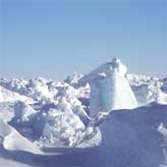Ice Formation
The first stage in sea ice development is the formation of individual ice crystals in the surface layer of the ocean. These crystals, known as frazil, form in open water areas when the temperature of the water is below -1.8°C. Frazil ice gives the water an oily appearance and with further freezing the crystals coagulate together to form a soupy layer at the surface known as grease ice.
How the sea ice proceeds to develop depends on whether the surface is calm or disturbed. With calm conditions the frazil and grease ice may consolidate into continuous flexible sheets called nilas. Nilas may be up to 10 cm thick, but is easily rafted under pressure, which can rapidly increase its thickness. Ice 10-30 cm thick is termed young ice, and with further rafting and ridging it develops into first-year ice (>30 cm). Finger rafting is a common process observed with nilas, where interlocking fingers of ice are thrust alternately over and under each other where two nilas sheets converge.
A common process of sea ice development in the Antarctic, which occurs under rougher conditions, is the "pancake cycle". With the influence of wind and wave action the frazil crystals coagulate, eventually consolidating into small circular discs of ice called pancakes. The pancakes have raised rims due to collisions with other pancakes, and grow by accumulating ice crystals from the surrounding water. By rafting and bonding together the pancakes may rapidly increase to a few metres in diameter and up to 40 cm thick, and eventually freeze together to form larger floes or a consolidated ice cover.
Although new ice forms most rapidly in open water areas with the development of frazil crystals, ice also grows on the underside of existing floes as heat is conducted from the ice-water interface through the floe. This ice is called congelation ice and consists of characteristic long columnar crystals, distinct from the small randomly oriented crystals of frazil ice.
New ice may also be formed from the freezing of flooded snow overlaying the sea ice. When the weight of the snow is sufficient, the ice surface may be depressed below sea level. The influx of sea water through the permeable snow saturates the lower layers of snow which may subsequently refreeze to form "snow-ice". Snow ice has a similar texture to ice formed from coarse grained frazil but may be discriminated from frazil by stable isotope analysis. Compared with sea water, Antarctic snow is relatively depleted in the heavy stable isotope, 18O, and therefore has a highly negative del18O value.
Analysis of 173 cores taken on six voyages into the East Antarctic pack between 1991 and 1995 revealed that on average the pack was comprised of 39% columnar ice, 47% frazil ice and 13% snow ice, with other ice types making up the remaining 1%. These figures indicate the importance of the dynamic processes within the pack, which favour the growth of frazil ice. Snow ice is also seen to make a significant contribution to the total ice mass of the region.

